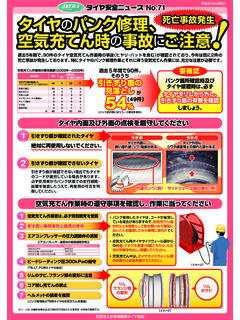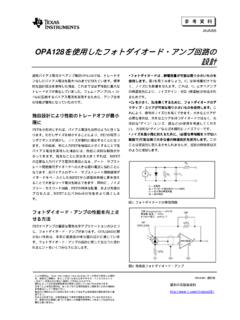Transcription of Tyre LCCO2 Calculation Guidelines Ver. 2 - JATMA
1 Tyre LCCO2 Calculation Guidelines Ver. April 2012 The Japan Automobile Tyre Manufacturers Association, Inc. Table of Contents I. Introduction .. 1 II. Philosophy of LCCO2 Calculations .. 4 1. Purpose .. 4 2. Targeted tyres .. 4 3. Greenhouse Gasses Targeted for Calculation .. 4 4. Scope of Lifecycle to be Calculated (System Boundary and Standard Flow) .. 4 5. Calculation Units .. 6 6. Inventory Types .. 6 7. GWP (Global Warming Potential) Sources .. 6 8. Calculation Precision .. 6 9. Compliance with Standards .. 6 III. Calculation Methods (Examples) at Each Stage .. 7 1. Raw Material Stage .. 7 1) Raw Materials Configuration Ratio .. 7 2) GHG Emission in Manufacture of Raw Materials.
2 8 3) GHG Emission in Shipping of Raw Materials .. 9 4) GHG Emission Amount in the Overall Raw Material Stage .. 11 2. Manufacturing Stage .. 12 1) GHG Emission Coefficient by Energy .. 12 2) GHG Emission Amounts in Manufacturing Stage .. 12 3. Distribution Stage .. 14 1) Scenario Setting for Tyre Product Shipping .. 14 2) GHG Emission Amounts in Distribution Stage .. 15 4. Usage Stage .. 15 1) Setting for Tyre Usage Conditions .. 15 2) GHG Emission Amounts in Usage Stage .. 16 5. End of Life & Recycling Stage .. 16 1) End of Life and Recycling Ratios by Usage of Used tyres .. 16 2) GHG Emission in Amounts Shipping of Used tyres .. 17 3) GHG Emission and Emission Reduction Effect in Thermal Recycling .. 18 4) GHG Emission and Emission Reduction Effect in Reused Products.
3 21 5) GHG Emission in Reuse of Materials .. 26 6) GHG Emission Amount and Emission Reduction Effect in the End of Life and Recylcing Stage .. 30 6. GHG Emission Amount in Lifecycle .. 31 I. Introduction LCA (lifecycle assessment) is a method used for quantitatively calculating, analyzing and evaluating the impact on the environment throughout the entire lifecycle from procurement of the raw materials for the commercial product or service, to discarding and recycling. With LCCO2 , greenhouse gasses (hereinafter referred to as GHG) emitted through the entire lifecycle are converted to CO2 for Calculation . By visualizing GHG emission amounts, vendors will strive to reduce GHG emission amounts further by cooperating with other businesses that compose their supply chain, and conversely, consumers will transform their own consumer habits to one that consumes lower amounts of carbon, by utilizing information that is provided.
4 The Tyre Industry of Japan took the lead in the tide relating to LCA at the time, has a track record in collecting and using the Tire Inventory Analysis Trials LCA Analysis and Research Activities in the Rubber Industry (Issued November, 1998; hereinafter referred to as the 1998 Guidelines ) that was an example Calculation for automobile tyres conducted by the Japan Rubber Manufacturers Association, the Environmental Experts Committee and the LCA subcommittee. Meanwhile, last year, standards and systems and the like related to LCA (ISO Environment Standard 14000 Series, PAS2050, BPX30-323, GHG protocol, Japan Carbon Footprint Institution) in Japan and elsewhere were widened and revised. Domestically as well, discussions have been advanced in the study committee (Ministry of Economy, Trade and Industry/survey and research relating to GHG emission amount calculating standards for organizations that compose the supply chain; From June, 2010; the Ministry of the Environment/committee for GHG emission amount Calculation methods in the supply chain; From July, 2010) relating to LCA that is sponsored by related Ministries.
5 Also, considering that the 1998 Guidelines that had been used by the tyre and rubber industry until now had been in use for more than a decade, we believed that the tyre LCA Calculation methods needed to be reviewed. From 2010, JATMA , engineering committees and environmental committees have been considering these revisions. Furthermore, the Mizuho Information & Research Institute, Inc. cooperated and was consigned the work as an expert positioned for fairness, and the propriety of a third party to these Guidelines , and to apply the Guidelines the latest domestic and international trends and knowledge they uncovered. These Guidelines reference and follow standard contents such as ISO14044, the Japanese Carbon Footprint system, PAS2050, BPX30-323, and GHG protocol and the like, based on the 1998 Guidelines that have a track record for use.
6 Particularly, ISO14040:2006 and ISO14044:2006 which are international standards are indicators for satisfying the standard contents such as the assumed conditions and Calculation methods, excluding collection content of data implemented individually and issues such as some sensitivity analyses. It is possible to implement calculations that conform to those standards by using these Guidelines . However, this is not intended completely to cover the reporting formats and report items (for example the setting of functional units and standard flow) pursuant to ISO14040:2006 and ISO14044:2006, so when considering complete compliance with ISO14040:2006 and ISO14044:2006, the pertinent standard contents shall be referenced.
7 2 These Guidelines are an activity report on the environment committee, and summarize the basic methods for tyre LCA calculating methods. Furthermore, these Guidelines should provide some assistance in calculating tyre LCA by interested parties. [Notes] These Guidelines (this edition) are publicly released material. They have been released on the JATMA homepage and others. Note that the CO2 emission amounts and various data, including the raw materials listed in these Guidelines are representative data provided to aid in your understanding of the calculations. April 2012 The Japan Automobile Tyre Manufacturers Association, Inc. Technical Committee, Environment Subcommittee 3 Environment Subcommittee Members and Related Personnel Involved in Summarizing These Guidelines (Listed with title at the time of publishing) (Honorifics omitted) Company Name Title and DivisionNameTask Force Leader Bridgestone Corporation Fellow (Managing Director) of both Central Research Institute and eco-Activities Promotion DivisionYasushi Hirata Committee Member Assistant Carbon Management Promotion Unit, Strategic Environmental Planning Department Sunao Yamashita Committee Member Sumitomo Rubber Industries, Ltd.
8 Director of Safety and Environment Management Depertment, Manager of CSR Promotion Office Shinichi Miyazaki (From Jan. 2012)Previous Committee Member Director of Safety and Environment Management Depertment, Manager of CSR Promotion Office Kiyoshi Morikawa (To Jan. 2012) Committee Member The Yokohama Rubber Co., Ltd. Associate Director CSR Division, General Manager CSR & Environmental Affairs KanazawaCommittee Member Toyo Tire & Rubber Co., Ltd. General Manager Environment, Safety & Health Enhancement Dept. Technical Management CenterKenji Akamatsu Committee Member Michelin Tires Japan Corporation Manager of Environment Safety and Health Division Yoshinori Yamada(From Mar. 2011)Previous Committee Member Chief Engineer of Engineering Planning Section Shuji Koge (To Mar.)
9 2011) Head Office The Japan Automobile Tyre Manufacturers Association, Inc., Deputy General Secretary / Director of both Technical Department and General Affairs Department (Public Relations and Publicity)Satoru Otaka Head Office Chief of both Technical Department and General Affairs Department (Public Relations and Publicity)Junichi Kinoshita [Cooperative Business Consignment] Company Name Title and Division Name Mizuho Information and Research Institute, Inc. Senior Manager: Environment Energy; Section 2 Minoru MAEDAS enior Manager: Environment Energy; Section 2 Yuichi KISHIDA Senior Consultant: Environment Energy; Section 2 Hiroyuki UCHIDA Chief Consultant: Environment Energy; Section 2 Masahiko SHIBATA Environment Energy; Section 2 Yasushi FURUSHIMAM anager: Science Solutions Division Hirokazu SUZUKI Chief Consultant: Science Solutions Division Osamu KITAMURA 4 II.
10 Philosophy of LCCO2 Calculations 1. Purpose To calculate greenhouse gas emission amounts in the lifecycle of tyres . These Guidelines summarize the basic methods for calculating greenhouse gas emission amounts in the lifecycle of tyres . In view of the diffusion of fuel efficient tyres that have been in the market over the last few years, there is a method for quantitatively comparing general tyres and fuel efficient tyres 2. Targeted tyres PCR ( tyres for passenger vehicles) TBR ( tyres for trucks and busses) 3. Greenhouse Gasses Targeted for Calculation The following seven types of gasses are targeted for Calculation . Table 1.












